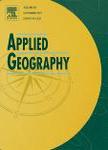版权所有:内蒙古大学图书馆 技术提供:维普资讯• 智图
内蒙古自治区呼和浩特市赛罕区大学西街235号 邮编: 010021

作者机构:Northwest Univ Coll Urban & Environm Sci Xian 710127 Peoples R China SouthernMarine Sci & Engn Guangdong Lab Guangzhou Guangzhou 511458 Peoples R China Chinese Acad Sci Res Ctr Ecoenvironm Sci State Key Lab Urban & Reg Ecol Beijing 100085 Peoples R China CASM State Key Lab Geoinformat Engn Key Lab Surveying & Mapping Sci & Geospatial Infor Beijing 100036 Peoples R China Middle Yarlung Zangbo River Nat Resources Observat Chengdu 610036 Peoples R China Ludong Univ Dongying Base Integrat Ind & Educ High Qual Dev Mo Dongying 257509 Peoples R China Yellow River Engn Consulting Co Ltd Zhengzhou 450003 Peoples R China
出 版 物:《APPLIED GEOGRAPHY》 (Appl. Geogr.)
年 卷 期:2025年第181卷
核心收录:
学科分类:07[理学] 0705[理学-地理学] 070501[理学-自然地理学]
基 金:National Natural Science Foundation of China Hunan Natural Science Foundation [2024JJ5393] Open Foundation of the Key Laboratory for Ecolog-ical Security of Regions and Cities [KLESRC2024-2-2] Open Foundation of the State Key Laboratory of Soil Erosion and Dryland Farming on the Loess Plateau, Northwest A F University [F2010121002-202420] Project of Southern Marine Science and Engineering Guangdong Laboratory (Guangzhou) [GML20220014]
主 题:Ecosystem service Socio-ecological factors Coupling relationships Network analysis Human activity Hainan Island
摘 要:Understanding the coupling relationships linking ecosystem services (ESs) and socio-ecological factors (SEF) is important to the sustainability of ecosystems. However, the majority of earlier research concentrated on the separate effects of SEF on ESs, without thoroughly investigating their coupling dynamics, trends, and the role of human activities. To address this gap, we analyzed the spatiotemporal variation of the ESs on Hainan Island from 2000 to 2020, including food production (FP), soil conservation (SC), water yield (WY), carbon sequestration (CS), water purification (WP), and habitat quality (HQ). Network analysis and the generalized additive model were used to investigate the coupling relationships and trends linking ESs and SEF. We also evaluated the variations of this coupling relationship under different human activity intensities. The results showed that HQ, WP, and CS exhibited relatively small changes during the study period, whereas SC, WY, and FP showed greater fluctuations. The coupling relationships linking ESs and SEF gradually weakened over time, with network complexity and connectivity declining. The positive contributions of HQ, CS, normalized difference vegetation index, and landscape pattern factors to network connectivity and complexity gradually diminished. In contrast, the negative contributions of SEF, including the percentage of construction land, gross domestic product, and percentage of cultivated land gradually increased. As human activity intensity increased, network connectivity and complexity showed a declining trend. This study not only offers new insights into comprehending the complex relationships linking ESs and SEF, but also provides theoretical support for future ecological protection policies on Hainan Island.